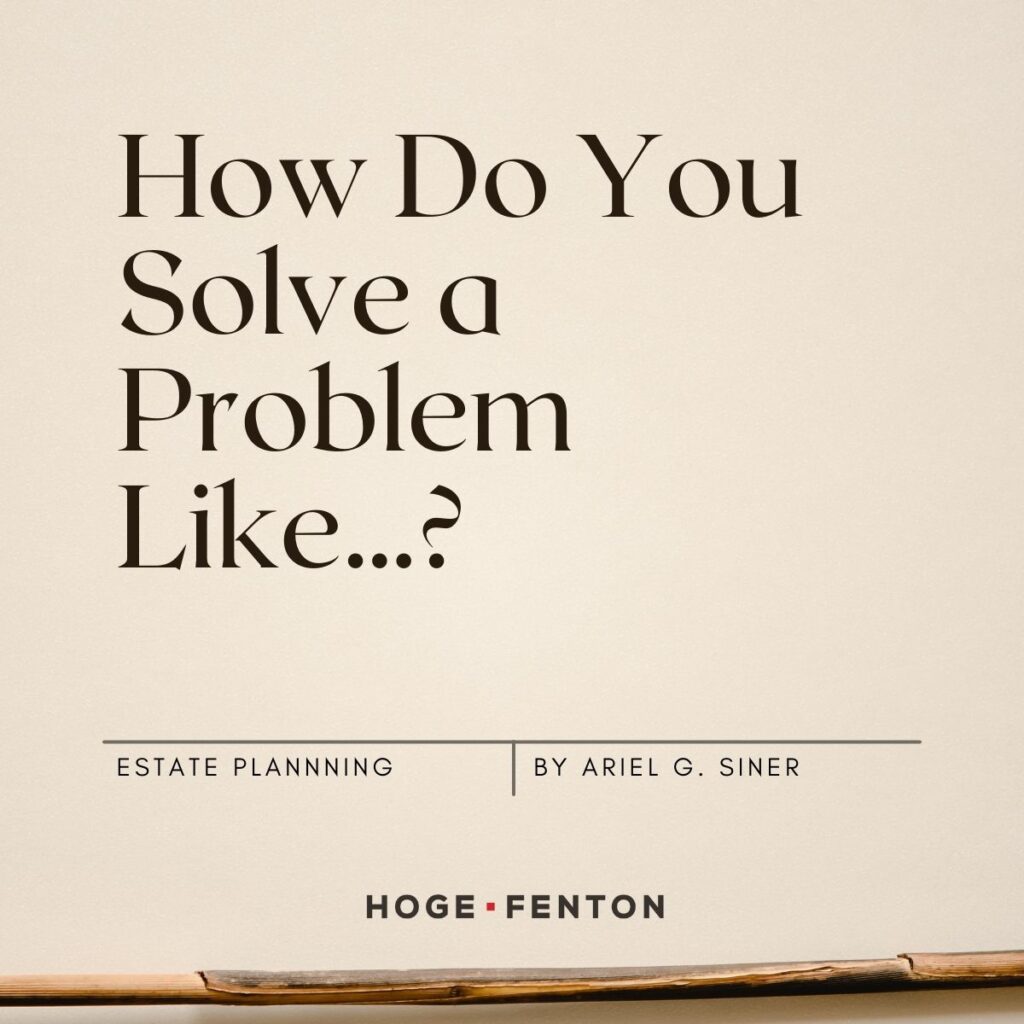How Do You Solve a Problem Like…?
By Ariel G. Siner | 03.21.2023 | Estates and Trusts

The goal of every single estate planning client can be boiled down to one thing: using assets to leave a legacy and to provide benefits to the people whom the client cares about after the client is gone. We often focus on the various tax planning strategies available, but that too furthers the underlying goal of maximizing the benefits that assets can provide to those we care about. Whether they are family members, charitable causes, or others, all estate planning furthers the goal of leaving assets to further the client’s legacy.
This goal is simple but the methods to achieve it often are not. Setting aside any tax planning considerations and following complex rules from the IRS, additional complications can come from the fact that people are people, and this is an emotional process. Unfortunately, the “human” element can complicate estate planning. Clients often envision their perfect world where their children all get along and put the assets they will inherit to the best use. Alas, that is rarely what actually happens.
An unfortunately common occurrence is when, for whatever reason, one of the client’s children has made bad choices and gotten into bad circumstances, and become estranged from the family. This can be anything from substance abuse to being in relationships with a person or people of whom the client does not approve. In those situations, the client feels one of two ways: they may want to provide financial assistance to the child or they may want to remove financial assistance from causing further harm to the child. Protecting a child from themselves or from the influence of those who may cause further destruction in the child’s life is an important part of the goal to use assets to benefit those people the client cares about.
One of the biggest benefits of working with an experienced estate planner is creating a customized estate plan that will work for the client and their family, oftentimes by using sophisticated tools and techniques. This article describes some benefits and potential drawbacks of some of those techniques.
For the sake of illustration, as an example, we will use a married couple with three adult children, one of whom—we will call him Chad—has substance abuse problems and has been in and out of rehab with relapses and some minor criminal charges.
So what can we do about Chad?
Disinheritance
“Chad has thrown away every opportunity he has been given. We don’t want him to inherit anything.”
This could very well be what the clients want to do about Chad. The estate plan can be drafted to completely disinherit Chad. He will be treated as though he predeceased the clients without issue—this means, even if Chad has children, they will not receive his share. The assets will be left to Chad’s siblings and maybe to some charitable organizations.
However, there may be a flaw in the plan. After the clients’ passing, Chad could be furious that he had been disinherited. He could try to contest the estate plan, claiming that his parents lacked capacity when they decided to disinherit him, or that his siblings unduly influenced their parents to cut him out. Unfortunately, this happens all the time. If Chad is motivated to make a mess and make things difficult for his siblings, he could do that. Even if he ultimately loses because his claims have no merit, it may take a lot of time and expense to resolve the situation.
No-Contest Clause
There is a way to limit litigation, though it is not guaranteed. A no-contest clause can be included in the estate plan to essentially say that if any beneficiary litigates or legally objects to the validity of the estate plan (absent probable cause to do so), they forfeit any benefit they would otherwise be entitled to under the plan. For Chad, if he is completely disinherited, there is nothing to lose by contesting the estate plan. But if he stands to receive $20,000, he may think twice about forfeiting that benefit.
Disinheritance versus an effective no-contest clause are potential costs and benefits to evaluate for the client’s own preferences and values, but there are ways to structure things to meet those needs.
Holding Assets in Trust
“We want to help Chad, but he cannot be trusted to handle money for himself. We want him to receive benefits without him being in control.”
In this situation, the clients want Chad to receive equal benefits along with his siblings but know that giving him a lot of money or assets directly would be detrimental to his well-being.
There are countless options for holding assets in trust for Chad’s benefit. A trustee—typically a professional, in cases like this—would manage the assets and make distributions either to him or for his benefit. The trustee can be given detailed guidelines as the clients see fit. For example, the trustee could be instructed to pay rent for a two-bedroom apartment for Chad. The trustee could alternatively be given the discretion to purchase a house or condo for Chad to be owned by the trust so that Chad always has a place to live but is not able to sell the house or use it as collateral. The trustee can be given guidelines about clothing, food, and entertainment allowances. The trust can even include a prohibition on distributions directly to Chad if he is under the influence of illegal substances (and provisions that include guidelines on how to get testing and results to the trustee).
Guidelines like these greatly assist the trustee, but it is also important to give the trustee discretion. There will always be circumstances that arise that the client could not foresee, and the trustee needs to be able to use the guidelines to be able to make decisions in any given situation. What if Chad gets married? What if Chad has children? What if Chad gets clean and goes back to school and wants to start a business? Many of those things may seem unlikely to the clients during the planning process but could happen decades later. For those reasons, it is important to ensure that instructions to the trustee are flexible so that the trustee is not unexpectedly limited.
So how do we solve a problem like Chad’s? Well, as with so many things, lawyers will say, it depends. But the important thing to remember is that there are options. No family situation is the same and therefore no estate plan is exactly the same. Customized approaches are a specialty for Hoge Fenton, and we are happy to discuss what options may work best for your circumstances.









